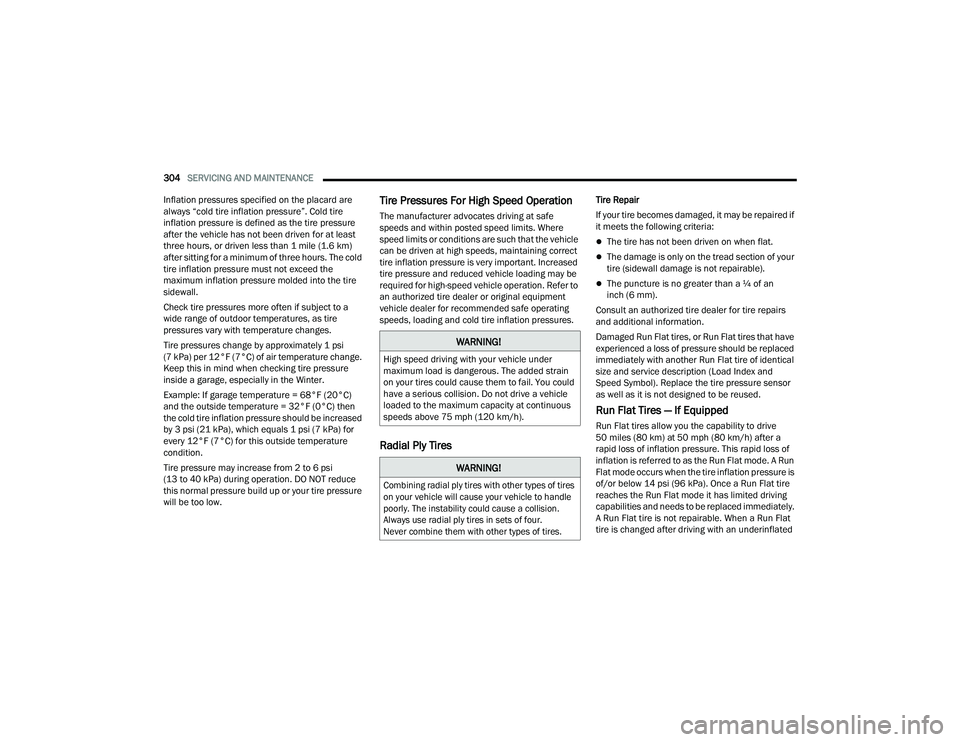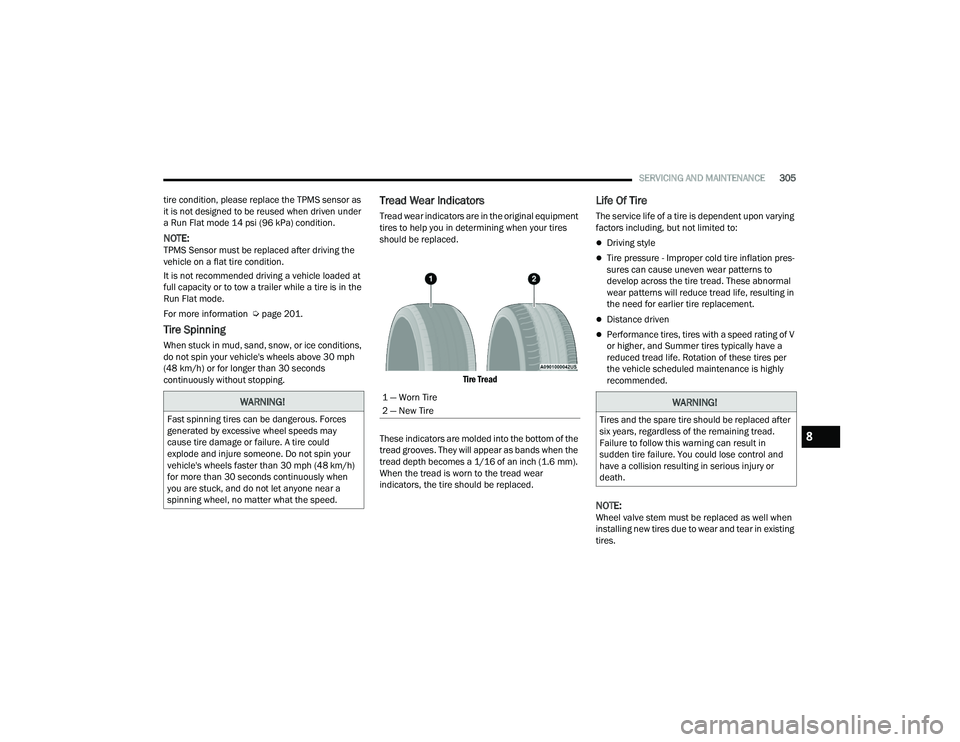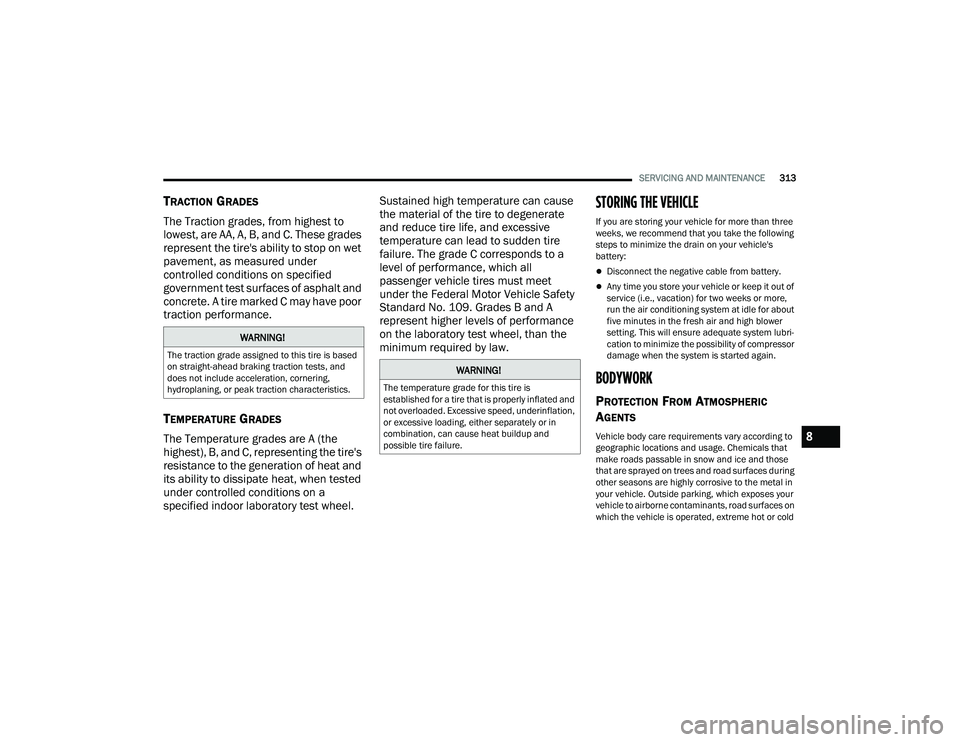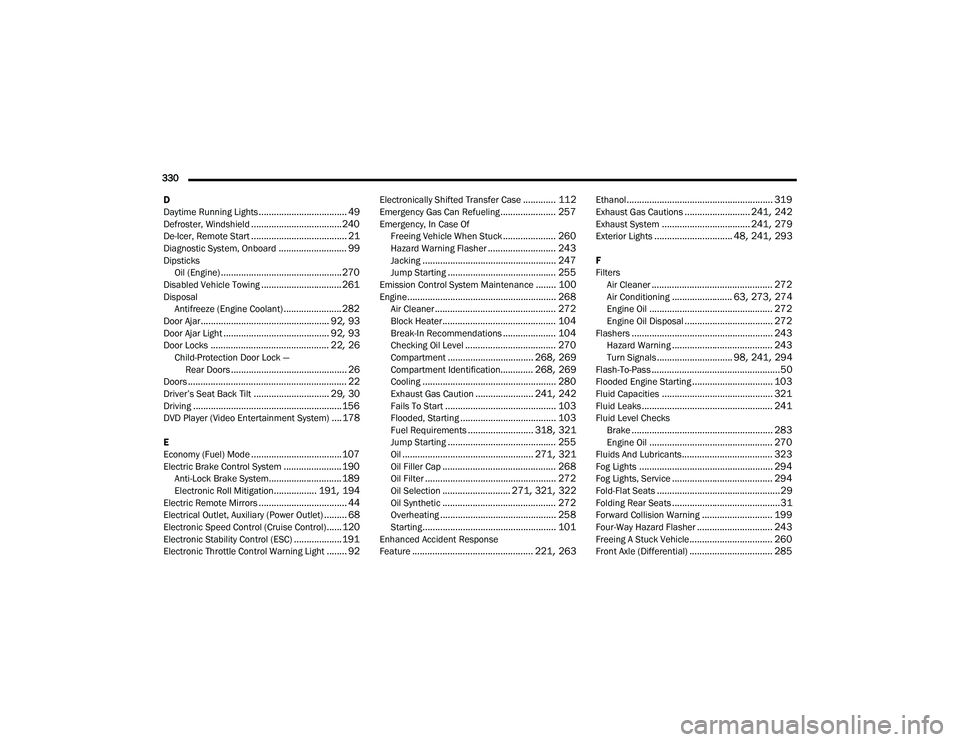run flat DODGE DURANGO 2021 User Guide
[x] Cancel search | Manufacturer: DODGE, Model Year: 2021, Model line: DURANGO, Model: DODGE DURANGO 2021Pages: 340, PDF Size: 20.38 MB
Page 306 of 340

304SERVICING AND MAINTENANCE
Inflation pressures specified on the placard are
always “cold tire inflation pressure”. Cold tire
inflation pressure is defined as the tire pressure
after the vehicle has not been driven for at least
three hours, or driven less than 1 mile (1.6 km)
after sitting for a minimum of three hours. The cold
tire inflation pressure must not exceed the
maximum inflation pressure molded into the tire
sidewall.
Check tire pressures more often if subject to a
wide range of outdoor temperatures, as tire
pressures vary with temperature changes.
Tire pressures change by approximately 1 psi
(7 kPa) per 12°F (7°C) of air temperature change.
Keep this in mind when checking tire pressure
inside a garage, especially in the Winter.
Example: If garage temperature = 68°F (20°C)
and the outside temperature = 32°F (0°C) then
the cold tire inflation pressure should be increased
by 3 psi (21 kPa), which equals 1 psi (7 kPa) for
every 12°F (7°C) for this outside temperature
condition.
Tire pressure may increase from 2 to 6 psi
(13 to 40 kPa) during operation. DO NOT reduce
this normal pressure build up or your tire pressure
will be too low.
Tire Pressures For High Speed Operation
The manufacturer advocates driving at safe
speeds and within posted speed limits. Where
speed limits or conditions are such that the vehicle
can be driven at high speeds, maintaining correct
tire inflation pressure is very important. Increased
tire pressure and reduced vehicle loading may be
required for high-speed vehicle operation. Refer to
an authorized tire dealer or original equipment
vehicle dealer for recommended safe operating
speeds, loading and cold tire inflation pressures.
Radial Ply Tires
Tire Repair
If your tire becomes damaged, it may be repaired if
it meets the following criteria:
The tire has not been driven on when flat.
The damage is only on the tread section of your
tire (sidewall damage is not repairable).
The puncture is no greater than a ¼ of an
inch (6 mm).
Consult an authorized tire dealer for tire repairs
and additional information.
Damaged Run Flat tires, or Run Flat tires that have
experienced a loss of pressure should be replaced
immediately with another Run Flat tire of identical
size and service description (Load Index and
Speed Symbol). Replace the tire pressure sensor
as well as it is not designed to be reused.
Run Flat Tires — If Equipped
Run Flat tires allow you the capability to drive
50 miles (80 km) at 50 mph (80 km/h) after a
rapid loss of inflation pressure. This rapid loss of
inflation is referred to as the Run Flat mode. A Run
Flat mode occurs when the tire inflation pressure is
of/or below 14 psi (96 kPa). Once a Run Flat tire
reaches the Run Flat mode it has limited driving
capabilities and needs to be replaced immediately.
A Run Flat tire is not repairable. When a Run Flat
tire is changed after driving with an underinflated
WARNING!
High speed driving with your vehicle under
maximum load is dangerous. The added strain
on your tires could cause them to fail. You could
have a serious collision. Do not drive a vehicle
loaded to the maximum capacity at continuous
speeds above 75 mph (120 km/h).
WARNING!
Combining radial ply tires with other types of tires
on your vehicle will cause your vehicle to handle
poorly. The instability could cause a collision.
Always use radial ply tires in sets of four.
Never combine them with other types of tires.
21_WD_OM_EN_USC_t.book Page 304
Page 307 of 340

SERVICING AND MAINTENANCE305
tire condition, please replace the TPMS sensor as
it is not designed to be reused when driven under
a Run Flat mode 14 psi (96 kPa) condition.
NOTE:TPMS Sensor must be replaced after driving the
vehicle on a flat tire condition.
It is not recommended driving a vehicle loaded at
full capacity or to tow a trailer while a tire is in the
Run Flat mode.
For more information Ú page 201.
Tire Spinning
When stuck in mud, sand, snow, or ice conditions,
do not spin your vehicle's wheels above 30 mph
(48 km/h) or for longer than 30 seconds
continuously without stopping.
Tread Wear Indicators
Tread wear indicators are in the original equipment
tires to help you in determining when your tires
should be replaced.
Tire Tread
These indicators are molded into the bottom of the
tread grooves. They will appear as bands when the
tread depth becomes a 1/16 of an inch (1.6 mm).
When the tread is worn to the tread wear
indicators, the tire should be replaced.
Life Of Tire
The service life of a tire is dependent upon varying
factors including, but not limited to:
Driving style
Tire pressure - Improper cold tire inflation pres -
sures can cause uneven wear patterns to
develop across the tire tread. These abnormal
wear patterns will reduce tread life, resulting in
the need for earlier tire replacement.
Distance driven
Performance tires, tires with a speed rating of V
or higher, and Summer tires typically have a
reduced tread life. Rotation of these tires per
the vehicle scheduled maintenance is highly
recommended.
NOTE:Wheel valve stem must be replaced as well when
installing new tires due to wear and tear in existing
tires.
WARNING!
Fast spinning tires can be dangerous. Forces
generated by excessive wheel speeds may
cause tire damage or failure. A tire could
explode and injure someone. Do not spin your
vehicle's wheels faster than 30 mph (48 km/h)
for more than 30 seconds continuously when
you are stuck, and do not let anyone near a
spinning wheel, no matter what the speed.
1 — Worn Tire
2 — New TireWARNING!
Tires and the spare tire should be replaced after
six years, regardless of the remaining tread.
Failure to follow this warning can result in
sudden tire failure. You could lose control and
have a collision resulting in serious injury or
death.
8
21_WD_OM_EN_USC_t.book Page 305
Page 315 of 340

SERVICING AND MAINTENANCE313
TRACTION GRADES
The Traction grades, from highest to
lowest, are AA, A, B, and C. These grades
represent the tire's ability to stop on wet
pavement, as measured under
controlled conditions on specified
government test surfaces of asphalt and
concrete. A tire marked C may have poor
traction performance.
TEMPERATURE GRADES
The Temperature grades are A (the
highest), B, and C, representing the tire's
resistance to the generation of heat and
its ability to dissipate heat, when tested
under controlled conditions on a
specified indoor laboratory test wheel. Sustained high temperature can cause
the material of the tire to degenerate
and reduce tire life, and excessive
temperature can lead to sudden tire
failure. The grade C corresponds to a
level of performance, which all
passenger vehicle tires must meet
under the Federal Motor Vehicle Safety
Standard No. 109. Grades B and A
represent higher levels of performance
on the laboratory test wheel, than the
minimum required by law.
STORING THE VEHICLE
If you are storing your vehicle for more than three
weeks, we recommend that you take the following
steps to minimize the drain on your vehicle's
battery:
Disconnect the negative cable from battery.
Any time you store your vehicle or keep it out of
service (i.e., vacation) for two weeks or more,
run the air conditioning system at idle for about
five minutes in the fresh air and high blower
setting. This will ensure adequate system lubri-
cation to minimize the possibility of compressor
damage when the system is started again.
BODYWORK
PROTECTION FROM ATMOSPHERIC
A
GENTS
Vehicle body care requirements vary according to
geographic locations and usage. Chemicals that
make roads passable in snow and ice and those
that are sprayed on trees and road surfaces during
other seasons are highly corrosive to the metal in
your vehicle. Outside parking, which exposes your
vehicle to airborne contaminants, road surfaces on
which the vehicle is operated, extreme hot or cold
WARNING!
The traction grade assigned to this tire is based
on straight-ahead braking traction tests, and
does not include acceleration, cornering,
hydroplaning, or peak traction characteristics.
WARNING!
The temperature grade for this tire is
established for a tire that is properly inflated and
not overloaded. Excessive speed, underinflation,
or excessive loading, either separately or in
combination, can cause heat buildup and
possible tire failure.
8
21_WD_OM_EN_USC_t.book Page 313
Page 332 of 340

330 D
Daytime Running Lights
................................... 49Defroster, Windshield.................................... 240De-Icer, Remote Start...................................... 21Diagnostic System, Onboard........................... 99Dipsticks Oil (Engine)................................................ 270Disabled Vehicle Towing................................ 261DisposalAntifreeze (Engine Coolant)....................... 282Door Ajar................................................... 92, 93Door Ajar Light.......................................... 92, 93Door Locks............................................... 22, 26Child-Protection Door Lock —Rear Doors.............................................. 26Doors............................................................... 22Driver’s Seat Back Tilt.............................. 29, 30Driving........................................................... 156DVD Player (Video Entertainment System).... 178
E
Economy (Fuel) Mode.................................... 107Electric Brake Control System....................... 190Anti-Lock Brake System............................. 189Electronic Roll Mitigation................. 191, 194Electric Remote Mirrors................................... 44Electrical Outlet, Auxiliary (Power Outlet)......... 68Electronic Speed Control (Cruise Control)...... 120Electronic Stability Control (ESC)...................191Electronic Throttle Control Warning Light........ 92
Electronically Shifted Transfer Case............. 112Emergency Gas Can Refueling...................... 257Emergency, In Case OfFreeing Vehicle When Stuck..................... 260Hazard Warning Flasher........................... 243Jacking..................................................... 247Jump Starting........................................... 255Emission Control System Maintenance........ 100Engine........................................................... 268Air Cleaner................................................ 272Block Heater............................................. 104Break-In Recommendations..................... 104Checking Oil Level.................................... 270Compartment.................................. 268, 269Compartment Identification............. 268, 269Cooling..................................................... 280Exhaust Gas Caution....................... 241, 242Fails To Start............................................ 103Flooded, Starting...................................... 103Fuel Requirements.......................... 318, 321Jump Starting........................................... 255Oil.................................................... 271, 321Oil Filler Cap............................................. 268Oil Filter.................................................... 272Oil Selection........................... 271, 321, 322Oil Synthetic............................................. 272Overheating.............................................. 258Starting..................................................... 101Enhanced Accident Response
Feature................................................ 221, 263
Ethanol.......................................................... 319Exhaust Gas Cautions.......................... 241, 242Exhaust System................................... 241, 279Exterior Lights............................... 48, 241, 293
F
FiltersAir Cleaner
................................................ 272Air Conditioning........................ 63, 273, 274Engine Oil................................................. 272Engine Oil Disposal................................... 272Flashers........................................................ 243Hazard Warning........................................ 243Turn Signals.............................. 98, 241, 294Flash-To-Pass...................................................50Flooded Engine Starting................................ 103Fluid Capacities............................................ 321Fluid Leaks.................................................... 241Fluid Level ChecksBrake........................................................ 283Engine Oil................................................. 270Fluids And Lubricants.................................... 323Fog Lights..................................................... 294Fog Lights, Service........................................ 294Fold-Flat Seats.................................................29Folding Rear Seats...........................................31Forward Collision Warning............................ 199Four-Way Hazard Flasher.............................. 243Freeing A Stuck Vehicle................................. 260Front Axle (Differential)................................. 285
21_WD_OM_EN_USC_t.book Page 330